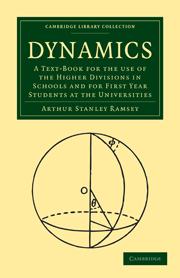 Dynamics
Dynamics Book contents
- Frontmatter
- PREFACE
- Contents
- Chapter I INTRODUCTION
- Chapter II VECTORS
- Chapter III RECTILINEAR MOTION. KINEMATICS
- Chapter IV RECTILINEAR MOTION. KINETICS
- Chapter V KINEMATICS IN TWO DIMENSIONS
- Chapter VI DYNAMICAL PROBLEMS IN TWO DIMENSIONS
- Chapter VII HARMONIC MOTION
- Chapter VIII MOTION UNDER CONSTRAINT
- Chapter IX THE LAW OF REACTION. GENERAL PRINCIPLES
- Chapter X GENERAL PROBLEMS
- Chapter XI IMPULSIVE MOTION
- Chapter XII POLAR COORDINATES. ORBITS
- Chapter XIII MOMENTS OF INERTIA
- Chapter XIV MOTION OF A RIGID BODY. ENERGY AND MOMENTUM
- Chapter XV EQUATIONS OF MOTION OF A RIGID BODY
- Chapter XVI MISCELLANEOUS PROBLEMS
- Chapter XVII SMALL OSCILLATIONS
Chapter I - INTRODUCTION
Published online by Cambridge University Press: 07 September 2010
- Frontmatter
- PREFACE
- Contents
- Chapter I INTRODUCTION
- Chapter II VECTORS
- Chapter III RECTILINEAR MOTION. KINEMATICS
- Chapter IV RECTILINEAR MOTION. KINETICS
- Chapter V KINEMATICS IN TWO DIMENSIONS
- Chapter VI DYNAMICAL PROBLEMS IN TWO DIMENSIONS
- Chapter VII HARMONIC MOTION
- Chapter VIII MOTION UNDER CONSTRAINT
- Chapter IX THE LAW OF REACTION. GENERAL PRINCIPLES
- Chapter X GENERAL PROBLEMS
- Chapter XI IMPULSIVE MOTION
- Chapter XII POLAR COORDINATES. ORBITS
- Chapter XIII MOMENTS OF INERTIA
- Chapter XIV MOTION OF A RIGID BODY. ENERGY AND MOMENTUM
- Chapter XV EQUATIONS OF MOTION OF A RIGID BODY
- Chapter XVI MISCELLANEOUS PROBLEMS
- Chapter XVII SMALL OSCILLATIONS
Summary
1·1. The subject of Dynamics is generally divided into two branches: the first, called Kinematics, is concerned with the geometry of motion apart from all considerations of force, mass or energy; the second, called Kinetics, is concerned with the effects of forces on the motion of bodies.
1·2. In order to describe the motion of a body or of a point two things are needed, (i) a frame of reference, (ii) a time-keeper. It is not possible to describe absolute motion, but only motion relative to surrounding objects; and a suitable frame of reference depends on the kind of motion that it is desired to describe. Thus if the motion is rectilinear the distance from a fixed point on the line is a sufficient description of the position of the moving point; and in more general cases systems of two or of three rectangular axes may be chosen as a frame of reference. For example, in the case of a body projected from the surface of the Earth a set of axes with the origin at the point of projection would be suitable for the description of motion relative to the Earth. But, for the description of the motion of the planets, it would be more convenient to take a frame of axes with an origin at the Sun's centre.
1·3. It is important to realize that there is no such thing as absolute time, but the period of rotation of the Earth relative to the fixed stars provides a unit of time, the sidereal day, which, so far as it can be tested with other time measures, is constant and therefore adequate for the purposes of ordinary dynamics.
- Type
- Chapter
- Information
- DynamicsA Text-Book for the Use of the Higher Divisions in Schools and for First Year Students at the Universities, pp. 1 - 5Publisher: Cambridge University PressPrint publication year: 2009First published in: 1929


